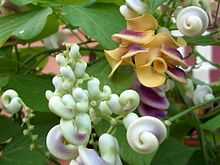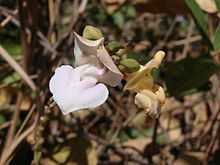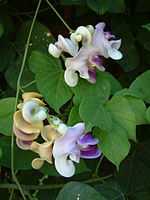Cochliasanthus
| Cochliasanthus caracalla | |
|---|---|
 | |
| The curled flowers of C. caracalla | |
| Scientific classification | |
| Kingdom: | Plantae |
| (unranked): | Angiosperms |
| (unranked): | Eudicots |
| (unranked): | Rosids |
| Order: | Fabales |
| Family: | Fabaceae |
| Subfamily: | Faboideae |
| Tribe: | Phaseoleae |
| Subtribe: | Phaseolinae |
| Genus: | Cochliasanthus Trew, 1763 |
| Species: | C. caracalla |
| Binomial name | |
| Cochliasanthus caracalla (L.) Trew | |
| Synonyms | |
| |
Cochliasanthus caracalla is a leguminous vine from the family Fabaceae, originating in tropical South America and Central America. The species is named caracalla, a corruption of the Portuguese caracol, meaning snail.[1][2] This perennial[3] vine (when grown in a climate without frost) has fragrant flowers said to be reminiscent of hyacinths - with a distinctive curled shape, giving rise to the common names corkscrew vine, snail vine, snail creeper, or snail bean. It is the only member of the genus Cochliasanthus and was formerly considered to belong to the genus Vigna.[4]
This vine is hardy in zones 9 and above, liking full sun and consistently damp soil. It prefers high heat and humidity. In colder zones, it does well in a pot if it is overwintered inside.
Thomas Jefferson called this plant "the most beautiful bean in the world".[3]
Consumption
Some data indicates some edible properties to this plant - specifically the flowers - but this should be verified from a reputable source before attempting. The seeds, which are technically beans, could be edible.[5] Parts of the true Corkscrew plant might be poisonous.[6]
Growing
Harvest
Flowers typically bloom in late summer or autumn[3][7] and, if pollination by ants is successful, seeds come soon after. Seeds grow inside pods, like pea pods. If the grower wants to cultivate them, pods should be removed from the plant while still green to prevent exposure to winter temperatures._seedpods.jpg)
Preparation
There is disagreement among growers on whether nicking the seed coat is more harmful or helpful to germination and some support nicking,[8] while others recommend against it. One widespread practice that does yield a high degree of success is to (pour boiling water on the seeds and) let the seeds soak overnight[8][9] in that water (as it naturally cools to room temperature).
Sowing
Burpee recommends that the seeds be sown in "ordinary soil in a sunny area in spring after danger of frost" has passed. The seeds should be planted two to three inches apart and covered with half an inch of "fine soil". Burpee then recommends growers to "firm lightly" the soil and "keep evenly moist".[10]
The seedlings will sprout in one to three weeks depending on the weather. If grown indoors or inside a greenhouse, then the seedlings can be moved outdoors when "spring temperatures remain above 50 F."[11] These plants will thrive in full sun[3] to partial shade and can attain a height of twenty feet.[10]
Flowers can blossom during the same growing season that the seeds were planted in.[12] The plant blooms for as much as eight weeks.[10]
It is possible to grow both vine species from cuttings.[9]
Confusion


The purple, non-fragrant, invasive flowers of the "Phaseolus giganteus" are said to have snail or snail-shell shaped flowers, hence the origin of the common name. The multicolored, fragrant, non-invasive flowers of the Cochliasanthus caracalla are said to have corkscrew or nautilus-shell shaped flowers, hence the origin of that common name. Though some claim that the leaves of one species are darker and differently sized compared to the leaves of the other, it is difficult to distinguish between these two plants through foliage alone. There have been multiple instances where both plants have been grown side by side for years and the discovery that they were not the same species was made only after the less mature plant finally bloomed. Both plants are pollinated by ants so, without ants, the plant will produce few, if any, seeds.[14][15]
Corkscrew Vine
_blooms.jpg)

Snail Vine


Immature flower buds often form fat half-crescents but, unlike the Corkscrew Vine, these buds are green, yellow, or brown. This plant might be more susceptible to aphids but is definitely invasive and has been compared by multiple growers to Kudzu. Rapid growth combined with the ability of vines touching the ground to take root make this an invasive plant.[18][19] This plant has been known to regrow even after all foliage visible above ground has died from frost.[19]
External links
- Differences between the two types
- Snail Vine, "Phaseolus giganteus"
- Corkscrew Vine, Cochliasanthus caracalla
- The Snail Vine - Confusion Reigns Supreme
References
- ↑ Giovanni Battista Triumfetti, Observationes de Ortu ac Vegetatione Plantarum (1685) pp.93-96
- ↑ Paul Amman, Hortus Bosianus (1686) p. 27
- ↑ 3.0 3.1 3.2 3.3 3.4 Monticello - Caracalla Bean. "Description, history, growth, and availability for sale"
- ↑ Delgado-Salinas A, Thulin M, Pasquet R, Weeden N, Lavin M. (2011). "Vigna (Leguminosae) sensu lato: the names and identities of the American segregate genera". Am J Bot 98 (10): 1694–715. doi:10.3732/ajb.1100069. PMID 21980163.
- ↑ http://www.sunnygardens.com/garden_plants/phaseolus/phaseolus_0317.php
- ↑ "Corkscrew Vine" http://www.easytogrowbulbs.com/p-1338-corkscrew-vine.aspx
- ↑ 7.0 7.1 Logee's Corkscrew Flower. "Care sheet"
- ↑ 8.0 8.1 How to Grow Cochliasanthus caracalla from Seed. "by Krystal Miller, Demand Media"
- ↑ 9.0 9.1 Growing information for Snail Vine.
- ↑ 10.0 10.1 10.2 Burpee Vigna Corkscrew. "Growing Information"
- ↑ 11.0 11.1 Park Seed - Fragrant Corkscrew Vine Seeds. "description, growth, sale"
- ↑ http://reviews.burpee.com/1031/prod000416/reviews.htm?sort=helpfulness
- ↑ 13.0 13.1 13.2 Almost Eden Snail Vine. "Description, growing, and sale information"
- ↑ http://toptropicals.com/cgi-bin/garden_catalog/cat.cgi?uid=Phaseolus_giganteus
- ↑ http://toptropicals.com/catalog/uid/vigna_caracalla.htm
- ↑ Almost Eden Corkscrew Vine. "Description, growing, and sale information"
- ↑ "Corkscrew Vine or Snail Vine" http://www.easytogrowbulbs.com/t-Corkscrew-Vine-or-Snail-Vine.aspx
- ↑ 18.0 18.1 The Snail Vine - Confusion Reigns Supreme. "discusses characteristics of each in detail"
- ↑ 19.0 19.1 Desert Tropical - Snail Vine. "description"
| Wikimedia Commons has media related to Cochliasanthus. |
| Wikispecies has information related to: Cochliasanthus |